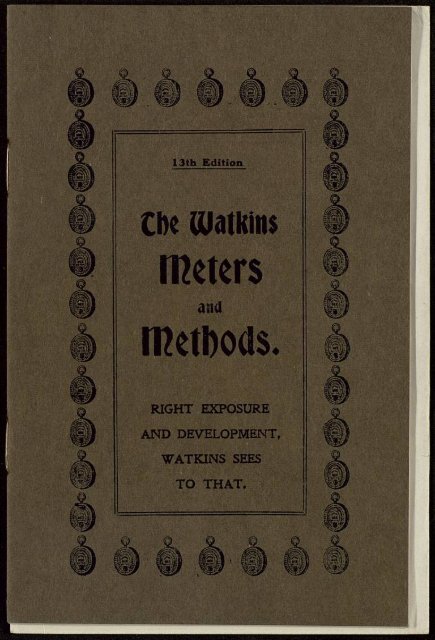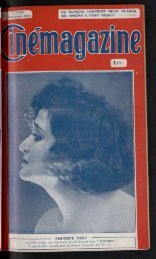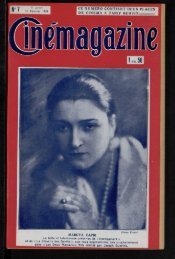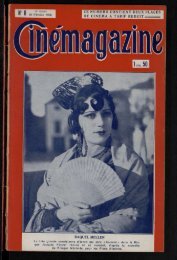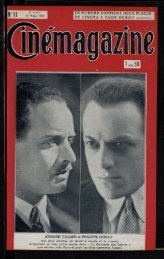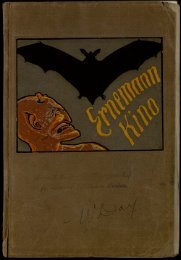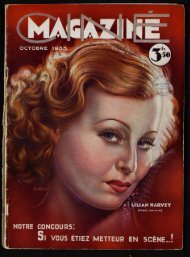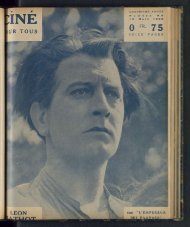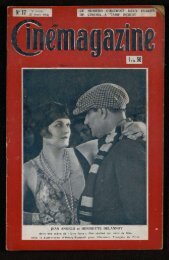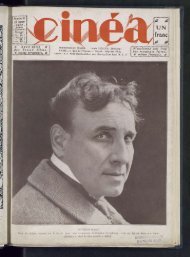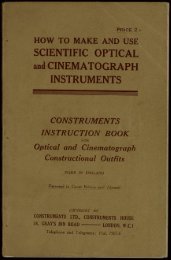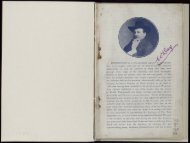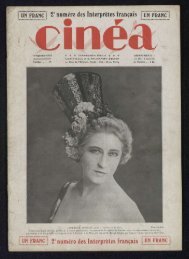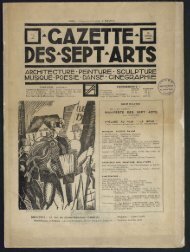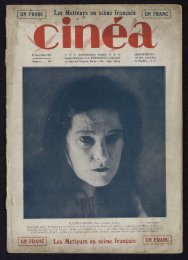You also want an ePaper? Increase the reach of your titles
YUMPU automatically turns print PDFs into web optimized ePapers that Google loves.
13th Edition<br />
CIK Olatkins<br />
meters<br />
ana<br />
metbods-<br />
RIGHT EXPOSURE<br />
AND DEVELOPMENT,<br />
<strong>WATKINS</strong> SEES<br />
TO THAT.
<strong>The</strong> Watkins Methods.<br />
EXPOSURE.<br />
HE Watkins <strong>Meter</strong>s indicate the<br />
correct camera exposures to give<br />
under all conditions, the basis<br />
being an actual test of the light<br />
by the sensitive paper in the meter,<br />
this one test taking the place of<br />
the elaborate classification of time,<br />
of day, year, position of subject,<br />
and state of weather in other<br />
calculators.<br />
Exposure depends on three<br />
influences—Plate Speed, Light,<br />
Diaphragm. <strong>The</strong> plate speed is given on our<br />
speed card. <strong>The</strong> light is tested by the sensitive paper<br />
in the meter, the number of seconds required to darken<br />
to tint being noted. <strong>The</strong> diaphragm (or stop used on<br />
the lens) is marked by the optician.<br />
In the Watkins <strong>Meter</strong>s a simple form of calculator<br />
estimates from these three influences the required exposure.<br />
All the meters are based on the same radical<br />
method with which the inventor practically created the<br />
modern exposure meter in 1890. <strong>The</strong> method is quite<br />
different from that of tables, and so-called meters, which<br />
make no actual light test, and which are only of<br />
assistance out of doors. <strong>The</strong> Watkins <strong>Meter</strong>s indicate<br />
difficult indoor exposures with exactness and certainty.<br />
TO TEST THE LIGHT.<br />
Hold the meter to face the source of the light which<br />
falls upon the subject, not to face the subject.<br />
<strong>The</strong> light which falls upon the worst lighted part<br />
of the subject in which detail is required in the negative<br />
is that to be tested.
<strong>The</strong> Watkins Methods.<br />
DEVELOPMENT.<br />
LMOST the whole power in<br />
development lies in regulating<br />
contrast between the tones, just<br />
as the whole science of exposure<br />
aims simply at securing a difference<br />
in light action for different tones.<br />
Control is exercised by using<br />
a uniform developer, and continuing<br />
development for just the<br />
right time to give the right contrast<br />
in the print, a short time<br />
tending to softness, a long time<br />
to vigour, or, in excess to hardness.<br />
Different subjects do not often require development<br />
variations, as a standard time gives the amount<br />
of contrast seen by the eye, whether it is a large or a<br />
small range of contrast. Time Development<br />
is therefore adopted, and the time varies greatly<br />
according to the brand of Plate and the Temperature<br />
even when a constant developer is used.<br />
<strong>The</strong>re are two distinct Watkins Time Methods<br />
(Factorial and <strong>The</strong>rmo), which are quite separate, and<br />
must not be confused. <strong>The</strong> First is :—<br />
THERMO= . . .<br />
DEVELOPMENT.<br />
This originated with Hurter & Driffield, and has<br />
been improved by Ferguson & Mees. In the Watkins<br />
Method the fact that different plates have different<br />
rates of development is allowed for by using different<br />
dilutions of the developer in accordance with a<br />
classification indicated on the Speed Card (this plan<br />
<strong>The</strong> Watkins Methods.<br />
is now used both for Time Developer as well as with<br />
the Time <strong>The</strong>rmometer). This makes the required<br />
variation for PLATE, the time being always the same<br />
at a given temperature.<br />
<strong>The</strong> variation for TEMPERATURE is indicated<br />
by the scale against the mercury in the Time <strong>The</strong>rmometer.<br />
Variations for subject (not often required)<br />
are made by dilution or concentration of developer.<br />
No dark room light is required, merely a darkened<br />
room.<br />
<strong>The</strong> temperature scale of the <strong>The</strong>rmometer is<br />
adapted to certain developers only, and we do not<br />
undertake to test others for their coefficient,<br />
efficiency, or energy.<br />
FACTORIAL . .<br />
DEVELOPMENT.<br />
A Dark Room light is required. <strong>The</strong> developer<br />
is poured on and the number of seconds elapsing<br />
before the first trace of image appears is noted. This<br />
" time of appearance " makes full allowance for both<br />
brand of plate and temperature, and dilution of<br />
developer, and multiplied by a fixed number (called<br />
the Watkins Factor, which varies for different<br />
developers) gives the total time of development for a<br />
standard contrast.<br />
For details see the Watkins Manual.<br />
Practically it is the exposure which decides the<br />
density of the negative, and development is timed so<br />
as to secure truthful gradation in the print, this is the<br />
end aimed at by the Watkins system.<br />
3.<br />
HHnnmHnm
OUR BUSINESS.<br />
HIS is unique. We do not sell<br />
general apparatus or appliances,<br />
only those embodying the methods<br />
of Mr. Watkins, all tending to<br />
accuracy and simplicity in<br />
Photography. Many of these<br />
instruments are new creations, not<br />
merely new patterns. We now<br />
make almost all we sell in our<br />
own Factory.<br />
Prices are so low that we<br />
must ask for postage in addition<br />
to list prices, and for stamp for reply to be enclosed<br />
with enquiries concerning methods.<br />
Our only way of giving speed information is by<br />
the id. Speed Card.<br />
Although our Instruction Books embody a large<br />
mass of expert trials, these were made for clients<br />
collectively, and we undertake no expert tests or trials<br />
(plates or developers) for individuals.<br />
WHAT TO BUY.<br />
<strong>The</strong> <strong>Meter</strong> is the main thing, the <strong>Bee</strong> in most<br />
cases (substituting Queen <strong>Bee</strong> or Stop-Watch <strong>Meter</strong> if<br />
luxurious, and adding extra dials for special purposes,<br />
if required) or the Focal Plane <strong>Meter</strong> if a hand camera<br />
only is used. <strong>The</strong> Manual is almost indispensible,<br />
and then comes the Time <strong>The</strong>rmometer. Few outdoor<br />
workers will omit Exposure Notes, and the Dark-<br />
Room Clock is a thoroughly useful and comfortable—<br />
not faddy—working instrument.<br />
A cheap and comprehensive outfit for all our<br />
methods is the <strong>Bee</strong> <strong>Meter</strong>, <strong>The</strong>rmometer, Manual and<br />
Exposure Notes, for 6/6, post free.<br />
4<br />
Instruction<br />
Booklets<br />
can be had<br />
in French.<br />
German,<br />
Spanish,<br />
Russian,<br />
Italian and<br />
Swedish.<br />
Refill for<br />
<strong>Bee</strong> <strong>Meter</strong> 6d.<br />
Post Free 7d.<br />
THE<br />
<strong>WATKINS</strong><br />
<strong>METERS</strong>.<br />
<strong>The</strong> <strong>Bee</strong> <strong>Meter</strong><br />
(PATENT)<br />
2/6 Ry P°st 2/7.<br />
For all out-door and in-door<br />
Camera Exposures.<br />
Complete in box with Speed Card, spare<br />
Discs behind pad, short and full<br />
instructions.<br />
Tho <strong>Bee</strong> <strong>Meter</strong> is a solidly made sound instrument<br />
which accurately tests the light, and its value must not be<br />
judged by its low price. It is far and away the moat<br />
successful and widely used of all aids to exposure, and its<br />
sales increase every year in spite of the number of plate and<br />
developer makers cardboard calculators, which have about<br />
a week's life in the pocket for every year's life of a <strong>Bee</strong>- It<br />
helps in difficult cases, applies to all plates, and can befitted<br />
with extra Dials for special uses at nominal cost. Solid white<br />
metal case with snap lid, Nickel plated, size 1} inches.<br />
INSTRUCTIONS: Grip front glass and back together, as in<br />
the illustration, and set the diaphragm against the plate<br />
speed. <strong>The</strong> exposure is then read against the light value<br />
as tested by the actinometer which is embodied in the<br />
instrument. To use it for copying or enlarging, tables are<br />
consulted.<br />
<strong>The</strong> <strong>Bee</strong> <strong>Meter</strong> can be used with a<br />
CHAIN PENDULUM if desired (auseful<br />
aid in counting seconds).<br />
1/- extra. By Post 1/1.<br />
<strong>The</strong> <strong>Bee</strong> <strong>Meter</strong> is sent out with any Special Dial (inplace<br />
of the regular one for IT stops) without extra charge,<br />
Autochrome Dial excepted. See page 6. See also pages 7,<br />
8 and 9 for other accessories or variations.
Extra Dials<br />
For BEE (and QUEEN BEE) METER.<br />
Note revised price—all 6d. (post id.) including tint,<br />
instructions, and speed card, except Autochrome, Queen<br />
<strong>Bee</strong> and Stop-Watch dials which are 1/- (post id.).<br />
Ordinary dial with whole tint (F stops).<br />
U.S. dial marked with U.S. Nos. for Kodaks, &c.<br />
J Tint dial 1 F Nos. <strong>The</strong>se calculate direct from<br />
> their tints without multiplying by 4<br />
TV Tint dial ) or 16. For interiors.<br />
Autochrome dial, also for other colour plates, makes<br />
a special calculation, 1/- (post id.)<br />
Special<br />
Dials &<br />
for the cheaper cameras with unmarked<br />
stops, one dial for each<br />
camera. We also can supply a<br />
dial for any camera with not more<br />
than 3 stops if the stop values are furnished. All 6d.<br />
(post id.) including tint, instructions and speed card.<br />
At present in stock for :—<br />
Nos. 1, 2, 2a, 3 and Stereo BROWNIE.<br />
Nos. 2, 2a, 3 and 3a FOLDING BROWNIE.<br />
Nos. 1 and ia FOLDING POCKET KODAK,<br />
VEST POCKET KODAK.<br />
Nos. 2 and 3 BULL'S EYE.<br />
No. 3b QUICK FOCUS.<br />
Nos. 1,000, 00A, 00B KLITO.<br />
Nos. 2i, 3J, 34 BOX ENSIGN.<br />
Nos. 2jA ENSIGN, 2JB FOLDING ENSIGN.<br />
Also for the ENSIGNETTE.<br />
All can be supplied for Queen <strong>Bee</strong> or Stop-Watch at<br />
1/-, but only the ordinary and U.S. are ivorine.<br />
6<br />
Instructions<br />
in English,<br />
French, or<br />
German.<br />
With<br />
Instructions.<br />
Autochrome <strong>Meter</strong><br />
3/= (Post Id.<br />
This makes a special calculation, and is applicable<br />
to other screen colour plates. Its sales have increased<br />
enormously in all parts of the World, as it has proved<br />
itself to he the only exposure guide for these valuable<br />
hut expensive plates.<br />
<strong>The</strong> case is that of the <strong>Bee</strong> <strong>Meter</strong>, and their dials<br />
interchan gea ble.<br />
Full Instructions.<br />
Indoor <strong>Meter</strong><br />
2/6<br />
(Post Id.)<br />
A new introduction for interior work, being fitted<br />
7with a TV tint, and a dial calculating from it.<br />
<strong>The</strong> Watkins <strong>Meter</strong> has 20 years reputation for<br />
interiors, and this embodies the most useful form.<br />
<strong>The</strong> case is that of the <strong>Bee</strong> <strong>Meter</strong>, and the dials<br />
interchangeable.<br />
Compass<br />
<strong>Bee</strong> <strong>Meter</strong><br />
3/6 (post id.)<br />
This has a small compass in back lid.<br />
Focal Plane<br />
<strong>Meter</strong><br />
3/6 By Post 3/7.<br />
A new <strong>Meter</strong> especially designed for Hand<br />
Camera work, the stops indicating against the<br />
shutter speeds.<br />
It is especially fitted for use in SNAP-<br />
SHOT WORK, and therefore indicates<br />
half the exposure of the other meters.<br />
Its case is different to that of all other <strong>Meter</strong>s, and,<br />
therefore, no other dials can be used in it, or its dial<br />
in any other case.
Instructions<br />
in French,<br />
German,<br />
Spanish,<br />
Italian, and<br />
Swedish.<br />
Far superior<br />
to all other<br />
<strong>Meter</strong> Paper.<br />
Queen <strong>Bee</strong> <strong>Meter</strong><br />
=— 10/6 -<br />
A refined hand finished edition of the <strong>Bee</strong><br />
<strong>Meter</strong>, the figures being engraved (not<br />
stamped) on the case.<br />
For all out-door and in-door<br />
camera exposures, one<br />
movement only.<br />
Silver-Plated<br />
Handsome Flat Ivorine Dial.<br />
Improved Inside Spring Plate Fitting.<br />
In Neat Leather Covered Pocket Case.<br />
Chain Pendulum for Seconds timing<br />
For extra dials, tints, refills, &c., see Pages 6, 8 and 9.<br />
Blue Glass.<br />
This baffles any attempt to make a colour match, and<br />
is therefore an improvement with many users. All dials<br />
can be supplied in blue glass at an EXTRA cost of 3d.<br />
(additional to cost in white glass).<br />
All <strong>Meter</strong>s can be supplied fitted with blue glass at an<br />
EXTRA cost of 3d. above the price of the <strong>Meter</strong>.<br />
DISC REFILLS<br />
(Fit all Watkins Watch Shaped <strong>Meter</strong>s)<br />
6d. (Post Id.)<br />
À " whole tint " on mask ready for the <strong>Meter</strong> is enclosed<br />
in each refill, hut a J or -rVth tint, or one of the varied<br />
openings described on Page 5, can be substituted without<br />
extra charge.<br />
RIBBON REFILLS<br />
6d. (Post id.)<br />
This STEADFAST Paper contains no soluble salt, and is<br />
most satisfactory.<br />
8<br />
V<br />
Figures<br />
are all<br />
Engraved,<br />
not stamped.<br />
Tints only<br />
either<br />
pattern<br />
lid.<br />
post free).<br />
<strong>The</strong> Triple<br />
Tint is<br />
withdrawn.<br />
Standard <strong>Meter</strong><br />
—= 15/= =—<br />
With Full Instructions<br />
and Speed Card.<br />
Provided with the subject and enlarging<br />
scales, which do not obtrude<br />
themselves when not wanted.<br />
<strong>The</strong> only instrument made which is<br />
absolutely complete for all problems,<br />
especially copying and enlarging without<br />
reference to Tables.<br />
Provided with a Pendulum.<br />
<strong>The</strong> ribbon of sensitive paper in this lasts longer<br />
without changing than disc refills.<br />
INSTRUCTIONS (for all ordinary subjects) : Set<br />
Pointer P to plate speed, D to the diaphragm. A to<br />
the light value and E will indicate the exposure.<br />
Standard <strong>Meter</strong> in Magnalium, £1 Is.<br />
Post Abroad, J/- extra.<br />
<strong>WATKINS</strong> TINT OPENINGS<br />
WITH EITHER<br />
WHOLE, 'A, OR Xie TINTS<br />
REGULAR DOUBLE BULLS<br />
EYE<br />
cEXTRA<br />
SIZE<br />
We now send out all <strong>Meter</strong>s with a single<br />
"whole tint" only—a half circle of tint and a half<br />
circle opening. 20 years experience convinces us<br />
that this is not only better than having 2 tints in<br />
sight, but is better than a "bull's eye" opening.<br />
<strong>The</strong> above block shows the "regular" tint, and<br />
also the other shapes which we are always willing to<br />
send to order, either with <strong>Meter</strong>, Dial, or Refill,<br />
without extra charge over stock pattern. <strong>The</strong> J and<br />
•jîg- tints are best carried on a separate. Dial, and the<br />
leather Exposure Note Wallet will carry these. In<br />
the Standard <strong>Meter</strong> (above) the £ tint is provided on<br />
the back of the whole tint, the mask is reversible and<br />
only one type of opening (regular) is applicable.<br />
9
m<br />
THE<br />
WatKins Time<br />
<strong>The</strong>rmometer.<br />
(Patent).<br />
Temp. Coeff. i-g.<br />
Indispensible for Tank<br />
Development.<br />
No dark room light required.<br />
Right for Kodak Film Tanks<br />
and Developer.<br />
2/6 Post Free 2/7-<br />
<strong>The</strong> time to develop is read directly from the<br />
height of the mercury without calculation or<br />
adjustment of any kind, the time for 6o° being<br />
fixed at 6| minutes. <strong>The</strong> other scale reading<br />
longer times for tank development.<br />
<strong>The</strong> strength of developer is adjusted (once for all)<br />
to make the standard time right for the particular<br />
plate, and for the user's choice of contrast in negative.<br />
<strong>The</strong> <strong>The</strong>rmometer thus allows for temperature<br />
variations, and the dilution of developer for plate<br />
variations.<br />
Either one of at least seven different developers<br />
(formulae are given for two) can be used, and a tablé<br />
of dilutions is given for each.<br />
CAN BE USED WITH<br />
Pyro Soda, Metal Quino! (formulae given),<br />
Rodinal, Certinal, Azol, Victol.<br />
Special Time <strong>The</strong>rmometer for "Autochromes"<br />
(set at i\ mins. at 6o°.)<br />
„ „ „ for " Rodinal."<br />
for "Rytoi."<br />
„ „ „ for " Kodol."<br />
Price 2/6 each.<br />
10<br />
Stop=Watch<br />
<strong>Meter</strong>. 0 35/=<br />
A Swiss made, fly back, centre seconds time<br />
recorder, with a Queen <strong>Bee</strong> <strong>Meter</strong> cleverly fitted<br />
in the back. <strong>The</strong> hands of the Watch (both<br />
seconds and minutes) start from zero at first<br />
pressure of the button, stop at the second, and<br />
fly back to zero at the third. <strong>The</strong> exact time<br />
can therefore be taken by pressure of the button<br />
as soon as the <strong>Meter</strong> has darkened to its tint ;<br />
the <strong>Meter</strong> being perfect both for out-door and<br />
interior use.<br />
Stock pattern with <strong>Bee</strong> scales (down to -550-th<br />
and F/4) also can be had with Focal Plane scales<br />
at same price.<br />
<strong>The</strong> flat dials are interchangeable with<br />
Queen <strong>Bee</strong>.<br />
We were the first to make a Stop-Watch<br />
<strong>Meter</strong>, and the present improved pattern with<br />
flat scales is the result of two years experience<br />
using them. Nickel-plated.<br />
New Time Tank<br />
( See next page J.<br />
ri
FOR<br />
PLATES<br />
NOT<br />
FILMS.<br />
NO<br />
DARK<br />
ROOM<br />
LIGHT<br />
REQUIRED,<br />
BUT<br />
DARKENED<br />
ROOM<br />
TO PUT<br />
IN PLATES.<br />
See previous f>age for Illustration.<br />
Daylight<br />
Time Tank<br />
Now made in our own Factory, and vastly<br />
improved on the earlier cheap zinc pattern.<br />
In heavy German silver, nickel plated.<br />
Specially designed for .use with a <strong>The</strong>rmometer.<br />
It is in two solid parts, and has<br />
no caps, chains, catches, taps, rubber bands, wires<br />
or movable fittings. A special method of guiding<br />
plates into grooves. In present pattern the top lid<br />
is turned over, and the light trap at spout is new.<br />
<strong>The</strong> washing inlet is trapped.<br />
Since we revised instructions for pouring in<br />
developer (tilting tank sideways), air bells do not<br />
occur.<br />
<strong>The</strong> plates are horizontal, so a small number<br />
can be developed with less than a tankful of<br />
developer. It is for daylight use and holds 11 plates.<br />
Any tank can be furnished (to order) with a<br />
lid and rack for any smaller size, the cost of lid<br />
and rack being one-half the full price of the<br />
complete tank. But it is preferable (on account of<br />
quantity of developer used) to get a complete<br />
small tank, and we now make a separate size of<br />
body for each size of plate (as per list below).<br />
if X 2-rV 9/- i plate 14/i<br />
plate 9/- 8| x 61 18/-<br />
3i X 3i 9/- 9 X 12 cm 12/-<br />
3i X 2i 9/- 10 x 15 cm 14/-<br />
5x4 12/- 13 x 18 cm 16/-<br />
5i X 3J 14/- 45 X107 mm 9/.<br />
Si x 3J 14/-<br />
Postage 5d. extra.<br />
German silver sheaths for flat films, 4/6 per<br />
doz., x plate. No use for Premo or N.C.<br />
films.<br />
12<br />
Instructions<br />
in English<br />
or German.<br />
Large Dial. Centre Seconds. Stop Action.<br />
Watkins Clock.<br />
Instructions<br />
in English<br />
or German.<br />
10/6 with Full Instructions.<br />
THE <strong>WATKINS</strong><br />
Dark=Room<br />
Clock<br />
With 4 inch dial, minute and seconds<br />
divisions very plain for dark room, centre<br />
seconds hand, stop action, and outside indicator<br />
to mark the completed time.<br />
<strong>The</strong> 10 minute dial, giving large minute divisions, so<br />
convenient for time of development, is retained. <strong>The</strong><br />
figures also indicate the seconds, 1 being 10 seconds, 2,<br />
20 seconds, &c. <strong>The</strong> stop action enables both minute<br />
and second hand to be stopped at 0. Started on pouring<br />
on developer by pressing the lever, and stopped for an<br />
instant to read the time of appearance in seconds.<br />
Available for ANY TIMING PURPOSES, Buch as<br />
developing machine, enlarging, sensitising, &c. <strong>The</strong>.<br />
hands are black and very plainly distinguished in dark<br />
This Shows<br />
2h<br />
Minutes.<br />
Usual Clock.<br />
For use with watch or dark room clock<br />
THE <strong>WATKINS</strong><br />
Factorial ,„ Soiid<br />
Calculator Aluminium.<br />
2/= By Post 2/1.<br />
For calculating time of development by the Watkins<br />
Factorial method, in connection with Watkins Dark-<br />
Eoom Olock, or any other clock or watch, raised figures<br />
on silvery matt surface easily read in dark room.<br />
FULL INSTEUOTION Booklet included.<br />
13
Complete<br />
with<br />
Instructions<br />
in English<br />
or German.<br />
Complete<br />
with<br />
Instructions<br />
in English<br />
or German.<br />
To be<br />
had on<br />
Approval.<br />
Pinhole " Lens 99<br />
51=<br />
Instantly fits any lens flange<br />
Pleasing effects-<br />
Absolute Simplicity.<br />
For all size plates.<br />
Simple exposure calculation.<br />
With Four Holes<br />
Post Free 5/1.<br />
Gives Artistic Teiture.<br />
Any angle of view.<br />
No focussing-<br />
Good for copying-<br />
Works at any focus-<br />
<strong>The</strong> 5/- Pinhole Lens has four pinholes (W.P. 6, 8,10<br />
and 12) and larger focussing hole on revolving plate.<br />
An extra charge made for different selection of holes.<br />
<strong>The</strong> W.P. number is marked, and this multiplied by<br />
the focal distance gives the diaphragm value. Thus No. G<br />
at 8 inches would be l7/48, and if the exposure is<br />
calculated with this stop by the BEE METER and<br />
the calculated time is given in MINUTES instead of<br />
seconds it will be right. It can be used for wide or<br />
narrow angle views on the same size plate.<br />
Pinhole "Lens"<br />
With One Hole<br />
1/6 Post Free V7.<br />
<strong>The</strong> W.P. number marked on the stock size is No. 6.<br />
Other size apertures (W.P. 8, 10, 12) to order, state<br />
focus wanted, enclose stamp if reply wanted, or two<br />
stamps for Booklet with full particulars.<br />
<strong>WATKINS</strong><br />
<strong>The</strong>rmo=Calculator<br />
(PATENT)<br />
This is a laboratory calculating instrument, for calculating<br />
variations of time for temperature with ANY DEVELOPER<br />
of which the temperature co-efficient is known, or for<br />
calculating a temperature co-efficient from trials. <strong>The</strong><br />
circular calculating disc is 4 inches diameter. Adjustable<br />
to any temperature co-efficient.<br />
Supplied either with Fahrenheit or Centigrade scales.<br />
Price in brass, all figures engraved, 25/-<br />
14<br />
<strong>The</strong><br />
Wat&ins Manual<br />
1/= By Post 1/2.<br />
Fifth Edition. 50th Thousand.<br />
Revised for <strong>The</strong>rmo Development.<br />
A complete Handbook of Exposure by Actinometer and<br />
Time Development.<br />
THE BOOK THAT HELPS.<br />
"I find when I lend your Manual people never<br />
return it"—REV. J. A. RIVINGTON.<br />
"<strong>The</strong> most instructive and clear I have ever read."—<br />
G. W. BAILEY, JR.<br />
"A real treat, such as I have not enjoyed since<br />
Robinson's Pictorial Photography years ago,—full not of<br />
vain repetitions but of Common sense, basing its system<br />
on an idea which is worked out logically and practically."—"<br />
WOI.BOB.OUGH," in English Mechanic.<br />
"I "bought 2 or 3 Elementary Books, studied them<br />
hard, with the result that I con!d get nothing satisfying<br />
about exactitude of exposure and development. I bought<br />
your Manual and exposed and developed four very good<br />
negatives—my first practical attempt. <strong>The</strong>re's method<br />
in it, that's the whole secret of it."—THOS. PEBRANS.<br />
NEW CHEAP FORM.<br />
In Stout Paper Covers. Seventh Edition.<br />
Exposure Notes<br />
Price 3d., By Post 3àd.<br />
A neat pocket book, containing practicable ruled<br />
pages for noting down exposures and development.<br />
With classified pages for other notes, and all tables, &c.<br />
for the Watkins Methods.<br />
NOT AN ANNUAL.<br />
Designed either for use by itself, or as a refill forthe<br />
new leather wallet.<br />
Pigskin Wallet<br />
Price 2/-, or with Exposure Notes 2/3.<br />
Very best long wearing quality, far superior to most<br />
• shop leather goods. Loop with pencil, pockets for speed<br />
card, extra dials, &c. Sewn, not paste down.<br />
15
Official<br />
Testimony. SOUTH POLE.<br />
<strong>The</strong><br />
Maiûson<br />
Expedition<br />
also<br />
equipped<br />
With them.<br />
Fully<br />
Illustrated,<br />
6/- net,<br />
post free 6/5.<br />
June, 1910.<br />
" Your meters having served me so well in<br />
so many lands, I have decided that each sledging<br />
party on the Expedition shall have one, in the<br />
use of which I will instruct them."<br />
Dec, 1912.<br />
" Your exposure meters proved as reliable<br />
in the Antarctic regions as they have always been.<br />
In the extremely puzzling light of the Polar<br />
regions I should have been quite nonplussed at<br />
times without them. I have brought back many<br />
hundreds of negatives, the correct exposure of<br />
which they were the means of indicating."<br />
H. G. PONTING<br />
(Photographer in Captain Scott's<br />
Expedition).<br />
Photography<br />
Its Principles 6 Applications<br />
(Westminster Series)<br />
BY<br />
Alfred Watkins, F.R.P.S.<br />
" This is just what we wanted from Mr.<br />
Watkins, not a résumé of the thoughts and<br />
experiences of other people, but his own opinions,<br />
for there are few photographers of experience who<br />
will not be of opinion that the conclusions and<br />
experiences of Mr. Watkins are worth a library of<br />
compiled text-books."—Morning Post.<br />
(We can only supply these to retail customers, and<br />
must refer the trade to the Publishers, Messrs.<br />
Constable, London.<br />
16<br />
With SCOTT THE SOUTH POLE<br />
RECENT IMPROVEMENTS. We were first to issue this<br />
type, It is now perfected, and<br />
is the thinnest made. Can<br />
be had with Focal Plane<br />
Scales.<br />
Stop = Watch<br />
<strong>Meter</strong><br />
35/=<br />
NicRel Plated.<br />
A specially designed <strong>Meter</strong>forthe<br />
use of moving Picture Photographers.<br />
dues<br />
Kinematograph<br />
<strong>Meter</strong> = = 5/=<br />
With instruction booklet giving speed of<br />
shutter, and pendulum for timing seconds<br />
and half-seconds. Tells what stop to use<br />
for the light. Dial not applicable to <strong>Bee</strong><br />
<strong>Meter</strong>.<br />
Identical with previous Autochrome<br />
<strong>Meter</strong>, but for all colour and<br />
panchromatic plates.<br />
£>£>£><br />
Colour Plate<br />
<strong>Meter</strong> = 3/=<br />
<strong>The</strong> Dial (applicable to <strong>Bee</strong> <strong>Meter</strong> Case) 1/=.<br />
Instruction Booklet re-written. Postage of above, 1 d.<br />
<strong>WATKINS</strong> METER CO., HEREFORD.
Testimony—continued.<br />
" I bought one of your <strong>Bee</strong> <strong>Meter</strong>s in January, 1903,<br />
and have been using- it ever since and find it<br />
invaluable."—D.G.B. (April, ign).<br />
" <strong>The</strong> exposures given and taken from your card<br />
for . . . and . . . plates were correct, although they<br />
gave your numbers as 25 per cent above their H. &<br />
D."—J.T.R.<br />
" May I add my testimony to the great assistance<br />
I have received from the Manual and <strong>Meter</strong>. I have<br />
been at photography since the age of 13, and on<br />
looking through the negatives taken before I had<br />
your instrument (that is for 14 years) I cannot find<br />
one even approximately correctly exposed."—W.J.C.<br />
" Since using your Dark Room Clock, Developer,<br />
and <strong>Meter</strong> I have not lost a single plate."—P.J. W.<br />
" I am so pleased with your ^-plate tank, I would<br />
like one for |-plate."—Mrs. W. A. P.<br />
" I am delighted with the Manual in its new form.<br />
You call it a beginners' hand-book, I should call it<br />
the book for photographers, for I know of no other<br />
in existence which gives so clearly and so accurately<br />
the very latest information as to the scientific basis on<br />
which negative making depends."<br />
—W.B.F. (K.C. and F.R.P.S.).<br />
"I am very pleased with the 3ix2j tank, it is a<br />
beautifully made article and very simple and effective<br />
in use."—A.L.<br />
" I have shown my meter and results I have obtained<br />
with it to my friends, who found them so<br />
satisfactory that they requested me to procure similar<br />
ones. In about 18 to 20 exposures, varying from 2<br />
seconds to 14 minutes, I have not lost cne plate."<br />
—W.C. (Nice).<br />
" <strong>The</strong> ij-plate tank is far and away ahead of the<br />
many tanks now on the market. I am delighted<br />
with it."—S.F.S.R. (Commander H.M.S. ).<br />
<strong>The</strong> Progress Medal<br />
Of the Royal Photographic Society<br />
for 1910 has been awarded to Mr.<br />
Alfred Watkins for his work on<br />
Exposure and Development.<br />
IV.


